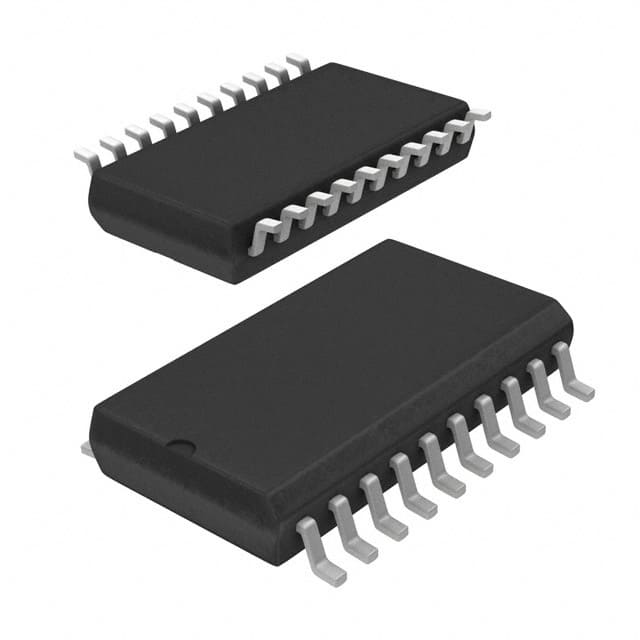MSP430F2101TDWR
Product Overview
- Category: Microcontroller
- Use: Embedded systems, Internet of Things (IoT) devices, and low-power applications
- Characteristics: Low power consumption, high performance, small form factor
- Package: TDWR (Thin Shrink Small Outline Package)
- Essence: A highly integrated microcontroller with advanced features for efficient and low-power operation
- Packaging/Quantity: Available in tape and reel packaging, quantity varies based on customer requirements
Specifications
- Architecture: 16-bit RISC
- Clock Speed: Up to 16 MHz
- Flash Memory: 2 KB
- RAM: 128 bytes
- Operating Voltage: 1.8V - 3.6V
- I/O Pins: 10
- Communication Interfaces: UART, SPI, I2C
- Analog-to-Digital Converter (ADC): 10-bit, 8 channels
- Timers: Multiple timers/counters
- Low-Power Modes: Various low-power modes for energy-efficient operation
Pin Configuration
The MSP430F2101TDWR microcontroller has a total of 20 pins. The pin configuration is as follows:
- VCC
- P1.0/TA0CLK
- P1.1/TA0.0
- P1.2/TA0.1
- P1.3/TA0.2
- P1.4/TA0.3
- P1.5/TA0.4
- P1.6/TA0.5
- P1.7/TA0.6
- GND
- P2.0/ACLK
- P2.1/SMCLK
- P2.2/TA1CLK
- P2.3/TA1.0
- P2.4/TA1.1
- P2.5/TA1.2
- P2.6/TA1.3
- P2.7/TA1.4
- RESET/NMI
- TEST
Functional Features
- Low power consumption enables battery-powered applications and extends battery life.
- High-performance 16-bit RISC architecture allows for efficient execution of instructions.
- Integrated communication interfaces (UART, SPI, I2C) facilitate connectivity with other devices.
- Analog-to-Digital Converter (ADC) enables precise measurement of analog signals.
- Multiple timers/counters provide accurate timing and event capture capabilities.
- Various low-power modes allow for energy-efficient operation in different scenarios.
Advantages and Disadvantages
Advantages: - Low power consumption makes it suitable for battery-powered applications. - Small form factor enables integration into compact designs. - High-performance architecture ensures efficient execution of instructions. - Integrated communication interfaces simplify device connectivity. - Multiple timers/counters offer versatile timing capabilities.
Disadvantages: - Limited flash memory and RAM may restrict the complexity of applications. - The number of I/O pins may be insufficient for certain projects requiring extensive external connections. - Lack of advanced features compared to more powerful microcontrollers.
Working Principles
The MSP430F2101TDWR operates based on a 16-bit RISC architecture. It executes instructions stored in its flash memory, utilizing various peripherals and interfaces to interact with the external environment. The microcontroller can enter different low-power modes to conserve energy when not actively processing tasks. It communicates with other devices through UART, SPI, or I2C interfaces, enabling data exchange and control. The integrated ADC allows for precise analog signal measurement, while timers/counters provide accurate timing and event capture capabilities.
Application Field Plans
The MSP430F2101TDWR microcontroller finds applications in various fields, including:
- Internet of Things (IoT) devices: Enables connectivity and control in IoT applications such as smart home systems, environmental monitoring, and wearable devices.
- Embedded systems: Suitable for embedded applications requiring low power consumption and high performance, such as industrial automation, medical devices, and consumer electronics.
- Low-power applications: Ideal for battery-powered devices where energy efficiency is crucial, such as wireless sensors, remote controls, and portable instruments.
Alternative Models
- MSP430F2111TDWR
- MSP430F2121TDWR
- MSP430F2131TDWR
- MSP430F2141TDWR
These alternative models offer similar functionality with varying specifications and memory capacities, allowing users to choose the most suitable option based on their specific requirements.
Word count: 520 words
قم بإدراج 10 أسئلة وإجابات شائعة تتعلق بتطبيق MSP430F2101TDWR في الحلول التقنية
Sure! Here are 10 common questions and answers related to the application of MSP430F2101TDWR in technical solutions:
Q1: What is MSP430F2101TDWR? A1: MSP430F2101TDWR is a microcontroller from Texas Instruments' MSP430 family, specifically designed for low-power applications.
Q2: What are the key features of MSP430F2101TDWR? A2: Some key features of MSP430F2101TDWR include a 16-bit RISC architecture, low power consumption, integrated peripherals, and a wide operating voltage range.
Q3: What are some typical applications of MSP430F2101TDWR? A3: MSP430F2101TDWR is commonly used in applications such as sensor nodes, battery-powered devices, industrial control systems, and home automation.
Q4: How does MSP430F2101TDWR achieve low power consumption? A4: MSP430F2101TDWR achieves low power consumption through various techniques like multiple low-power modes, clock gating, and efficient use of peripherals.
Q5: Can I interface MSP430F2101TDWR with external sensors? A5: Yes, MSP430F2101TDWR has built-in analog-to-digital converters (ADCs) that can be used to interface with external sensors.
Q6: What programming language is used for MSP430F2101TDWR? A6: MSP430F2101TDWR can be programmed using C or assembly language. Texas Instruments provides a development environment called Code Composer Studio for programming and debugging.
Q7: What is the maximum clock frequency supported by MSP430F2101TDWR? A7: The maximum clock frequency supported by MSP430F2101TDWR is 8 MHz.
Q8: Can MSP430F2101TDWR communicate with other devices? A8: Yes, MSP430F2101TDWR has built-in serial communication interfaces like UART, SPI, and I2C, which can be used to communicate with other devices.
Q9: Is MSP430F2101TDWR suitable for battery-powered applications? A9: Yes, MSP430F2101TDWR is well-suited for battery-powered applications due to its low power consumption and efficient use of peripherals.
Q10: Are there any development boards available for MSP430F2101TDWR? A10: Yes, Texas Instruments provides development boards like the MSP-EXP430G2 LaunchPad, which can be used for prototyping and evaluation of MSP430F2101TDWR-based solutions.
Please note that these questions and answers are general in nature and may vary depending on specific requirements and use cases.


